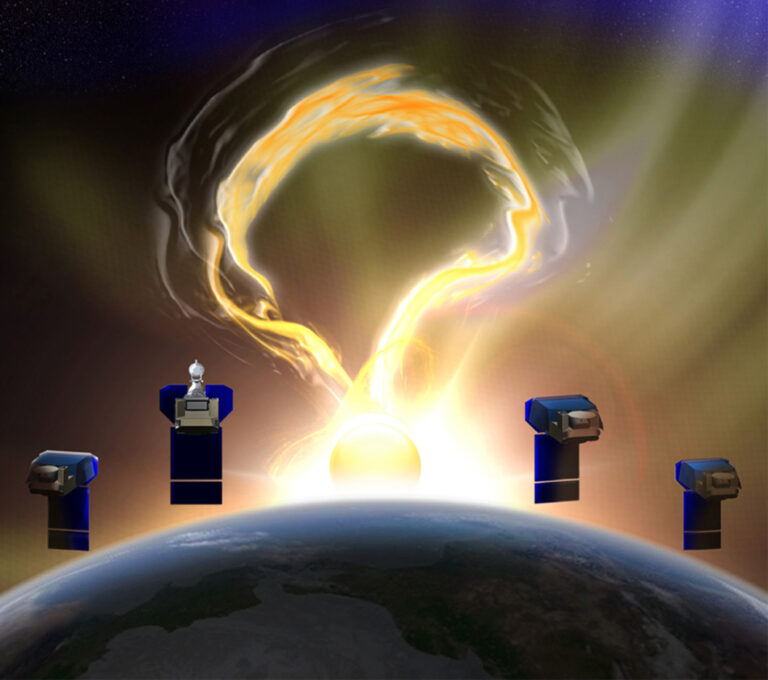Scientists know that a solar wind streams out of the Sun and rushes into the void of space, constantly buffeting Earth and the other planets with gales of charged particles. They’ve just never seen it – at least not as a seamless, connected process.
Instead, scientists have relied on a handful of solar-observing telescopes, none optimized to view the wind, to fit together the puzzle pieces of how the wind unfurls from the Sun, eventually breaking free of the star’s magnetic fields. The disjointed picture these instruments paint – which at best leaves gaping blind spots at the Sun’s poles – makes it difficult to determine how the wind evolves.
A recently funded constellation of four microsatellites, dubbed PUNCH (Polarimeter to UNify the Corona and Heliosphere), will change that.
“With existing instruments, we’ve always had to patch things together with gaps in between,” said Sarah Gibson, interim director of the High Altitude Observatory at the National Center for Atmospheric Research (NCAR), who is coordinating the mission’s science efforts. “PUNCH fills the gaps and combines data in a way that’s completely smooth and consistent. Everything is matched by design.”
PUNCH will also help researchers better understand the structure and trajectory of coronal mass ejections after they erupt from the Sun’s surface, information that could be critical to improving forecasts of how these space weather phenomena may impact Earth. Coronal mass ejections (CMEs) have the potential to endanger satellites and astronauts, and disrupt radio and GPS communications, and at their very worst, set off underground currents that can knock out power grids – but the degree of impact depends on their path away from the Sun and how their magnetic field is oriented in relation to Earth’s own.
PUNCH, which is being led by the Southwest Research Institute (SwRI), was selected in June by NASA to be funded as a Small Explorers (SMEX) mission. The target launch date for the satellites, each of which will weigh about 100 lbs once constructed, is in 2022.
Aside from NCAR and SwRI, other mission partners include the Naval Research Laboratory, Rutherford Appleton Laboratory, and a science team spanning several continents.
Mapping the wind
Scientists have long been curious about the transition between the Sun’s corona (or outer atmosphere) and the heliosphere (the bubble that surrounds all the planets and is permeated by the solar wind). Where does one start and the other end?
The PUNCH satellites will map the flow of the solar wind. The observations from PUNCH will be much more sensitive and cover a wider field of view than previous observations.
As the young solar wind flows through the corona, its behavior is still dominated by the Sun’s magnetic fields. But once it escapes the corona, its behavior changes. Observations of the solar wind made with the patchwork of existing telescopes suggest that the wind accelerates and becomes more turbulent once it leaves the corona, making it appear almost fluffy. Now scientists want to know the location of the boundary, called the Alfvén Zone, and if the fluffiness, called flocculation, in the observations is due to an actual change in the wind or just a byproduct of piecing together data from different telescopes.
PUNCH is designed to answer these questions. Its four, suitcase-sized satellites will, for the first time, continually map the flow of the young solar wind from the outer corona to the inner heliosphere.
“Because PUNCH has matched instruments, we can look at that transition and know whether what we’re seeing is because of the instrument or because of fundamental physics,” Gibson said.
The instruments onboard the four microsatellites are 10 times more sensitive than any previous telescopes and their formation – with one satellite close in and three working together to sweep an area further out – will ensure a continuous view.
A 3D view
The instruments onboard PUNCH will also observe both polarized and unpolarized light. Light can become polarized when it scatters off of particles in the atmosphere of Earth or the Sun. Measuring the polarized light and contrasting it with unpolarized light can give scientists a 3-dimensional look at the density and structure of the particles.
This can be especially helpful when trying to determine the impacts of a CME. Combining the information gleaned from both polarized and unpolarized images of a CME could allow scientists to determine its trajectory and better understand its structure, which in turn, could reveal the orientation of its magnetic field, according to Gibson.
The PUNCH satellites will have a hard time gleaning this information about CMEs hurled directly toward Earth, since they are observing the Sun from Earth’s own orbit. However, PUNCH observations of CMEs with trajectories away from the Earth will provide unique information that can inform future space weather prediction methods.
“Photographing the sky in polarized light is the secret sauce of the mission,” said SwRI scientist Craig DeForest, PUNCH’s principal investigator. “When sunlight bounces off electrons, it becomes polarized. That polarization effect lets us measure how solar wind features move and evolve in three dimensions, instead of just a 2D image plane. PUNCH is the first mission with the sensitivity and polarization capability to routinely track solar wind features in 3D.”



